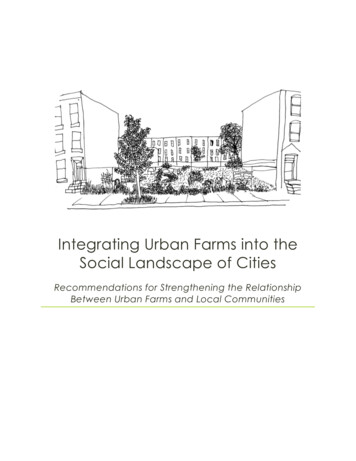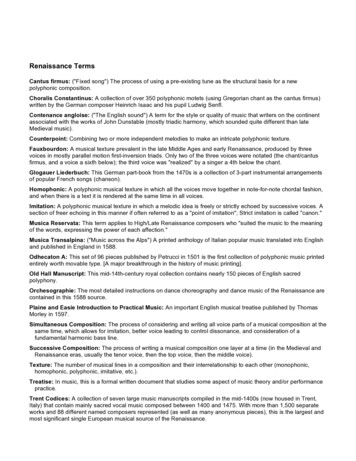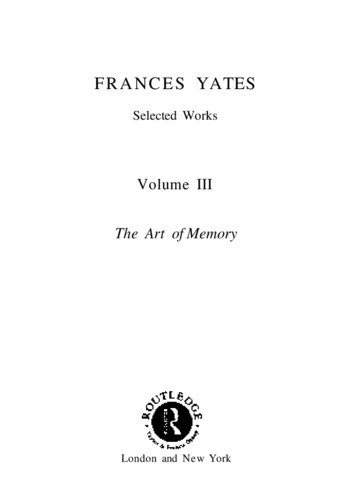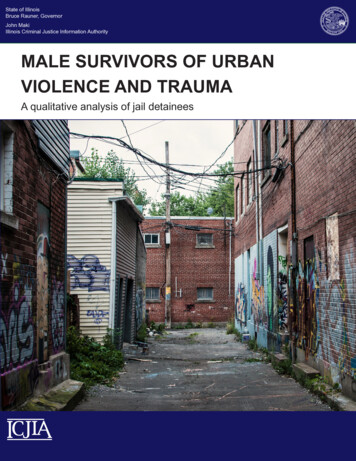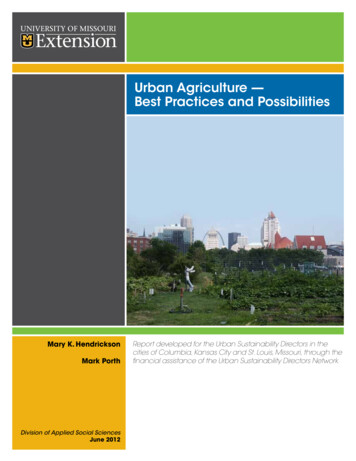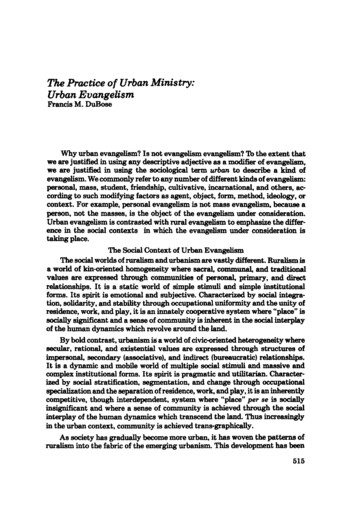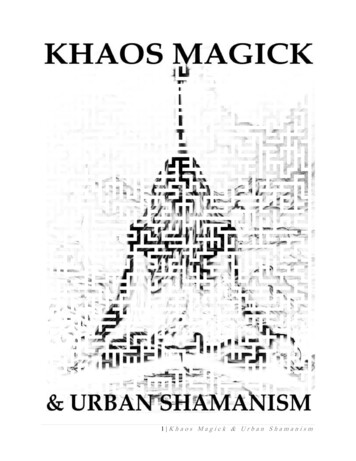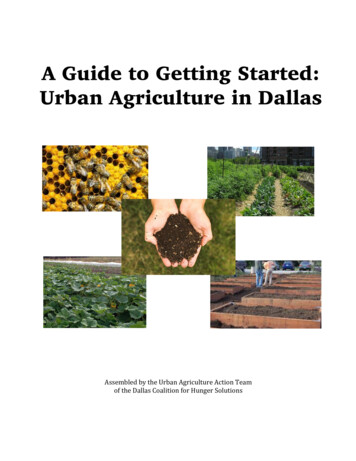
Transcription
RenaissanceUrbanization, UrbanDesign, and UrbanPlanningGeography 350,Introduction to UrbanGeographySeptember 17, 2012Elvin WylyItaly, About 1494. Florence (east of Corsica, inland and about midway between Genoa and Rome) was a Romantown that gained a certain degree of autonomy in the 1200s. Like many of the port cities across Italy, Florenceenjoyed a thriving commercial boom with textile and banking activity; then, a unique ‘Florentine School’ of paintersdeveloped here in the late 13th Century and through the 14th, leading a revival of Italian art that eventually came tobe known as the European Renaissance. Source: William R. Shepherd (1926), Shepherd’s Historical Atlas. NewYork: Henry Holt & Company. Public domain image, reproduced courtesy of the University of Texas Libraries,The University of Texas at Austin, Perry-Castañeda Library Map Collections.1
“As the nineteenth-century idea of unceasing change and ‘progress’ raises for ustoday the problem of stabilization and equilibrium, so the medieval idea ofsecurity raised, from the fourteenth century onward, the problem of how life,growth, and movement were to take place in a world governed by the ideas offixed custom and inherited privilege. Must the wall be torn down? Must thearmor be removed? Or did this civilization have the capacity to continue growthfrom its own center and so to arrive, without disintegration, at a wider synthesis?That was a problem for both its central institution, the Church, and for themedieval city: but neither could solve it without transcending its inheritedlimitations.”Lewis Mumford.1“.our knowledge of social conditions in the cities of early modern Europe willnever rest on the type of standardized statistical data which modern censusesroutinely produce for every modern city. Much as we may know about one parishor district or even one whole city during a particular period, the systematiccomparisons over space and time which modern social analysis takes for grantedcan never underlie discussions of the early modern city. Even the mostsophisticated comparative analyses of European urbanization in the early modernera ultimately depend on a patchwork of estimates and data of highly variantquality. Yet this is not to say that we will never know what we most want toknow about the early modern city. It all depends on what we are looking for. Ifwe step back from the relentless search for more data . we will soon discover nothow little we know but how much. . Despite their many differences in size andcharacter, the towns of early modern Europe all belonged to a commonurban civilization.”Christopher Friedrichs. 2“Years ago in some now-forgotten bookstore in Europe the author came across hisfirst map-plan of a city ‘Published under the Superintendence of the Society forthe Diffusion of Useful Knowledge.’ Having an interest in cities, their planning,and cartography, he routinely looked through the portfolio of miscellaneous mapsmaintained by many bookstores abroad. One by one, over a period of manyyears, 26 of these remarkable map-plans were collected. . Only Great Britain inthe 19th century could produce an institution with a name so unique that itcan hardly be ignored and purposes so apt and universal they can hardly bedisclaimed.”Melville Branch. 3These three quotes present an invitation to study an “urban revolution” that continues to shapeour urban world today. Lewis Mumford writes of security and city walls, Christopher Friedrichsdocuments a common urban civilization, and Melville Branch praises the urban design maps1Lewis Mumford (1961). The City in History. New York: Harcourt, Brace, & World, p. 335.Christopher R. Friedrichs (1995). The Early Modern City, 1450-1750. London and New York: Longman, p. 331.3Melville C. Branch (1997). An Atlas of Rare City Maps: Comparative Urban Design, 1830-1842. New York:Princeton Architectural Press. Second Edition, quote from p. 1.22
created by the “Society for the Diffusion of Useful Knowledge” as a unique achievement ofGreat Britain in the 1800s. All of these processes came together in Europe in a series of social,economic, and political transformations between the 1300s and the 1800s. European societiesemerged from a long period of war-torn isolation and stagnation -- variously described as theMiddle Ages, the medieval period, or the Dark Ages -- into a dynamic period of urbanization thatcame to be known as the “Renaissance.” The Renaissance -- translating as the revival or rebirth - shaped cities around the world. While the conventional wisdom on the emergence of the firstcities tells us that the “urban revolution” refers to ancient Mesopotamia, many urbanists regardthe European Renaissance as the true urban revolution -- since it produced not just big cities, butentire national societies that became majority urban.The urban revolution of the European Renaissance was felt across the entire world, andcontinues to shape the interplay between today’s ideas of modernity and the legacies of the past.The European story is fascinating, but it’s not just a story of great cities. While Europe wasstruggling through the darkest of the Dark Ages, Changan, China -- present-day Xi’an -- hadmore than a million people in the 7th century, and great cities thrived across the Greater MiddleEast and Japan for more than a thousand years. But it was European exploration and colonialismthat alternately destroyed, transformed, or engaged with existing societies across Asia, Africa,and the Americas.-- spreading institutions of modernity (development, infrastructure,governance) as well as violence (war, slavery, racism, genocide). World urbanism reflectedthese changes, because“.as it materialized in Europe and was exported with the creation of colonialempires after 1500 A.D., the European-created city became the model for urbangrowth and development worldwide. In some regions, it was imposed onindigenous societies that were exterminated and shoved aside (as in North andSouth America and Oceana). In regions with long histories of indigenous culturesand urban life, it existed alongside of and transformed indigenous cities (as inmost of Asia, the Greater Middle East, and Africa).”4In North America the links between present-day cities and the European transformations isparticularly explicit. As Jill Grant observes in an essay on the history of Canadian urbanplanning, notable shifts in European practice altered key facets of urban design and planning.“Extending their political and military domain to the New World, Europeans soon began theirown settlements in Canada. Some of the earliest communities initiated by those who came toreap the rich harvests of the sea and land developed in an essentially organic fashion, with noevident plan.”5 Such ‘organic’ urban forms in Canada are perhaps best illustrated by QuebecCity, founded by the French in 1608, reflecting the quintessential spatial layout of the medievalEuropean town. But things changed in only a few generations:4Donal J. Zeigler, Stanley D. Brunn, and Jack F. Williams (2003). “World Urban Development.” In Stanley D.Brunn, Jack F. Williams, and Donald J. Zeigler, eds., Cities of the World: World Regional Urban Development.Lanham, MD: Rowman & Littlefield, 1-45, quote from p. 27.5Jill Grant (2000). “Planning Canadian Cities: Context, Continuity, and Change.” In Trudi Bunting and PierreFilion, eds., Canadian Cities in Transition: The Twenty-First Century. Second Edition. Don Mills, ON: OxfordUniversity Press, 443-461, quote from p. 443.3
“By the eighteenth century, England and France enhanced control of their NorthAmerican colonies. Establishing towns became a keystone of colonial policy:control the land through new settlements. True to the popular Baroque traditionsof the time, the Europeans designed streets, squares, and markets in an elegantgeometry: eastern cities like Halifax, Charlottetown . and the French fortress atLouisbourg reveal such influences. This approach to planning reflected thetriumph of authority over landscape; despite the grade of the hill or the presenceof waterways, the formal pattern laid out by military engineers dominated. Legalsystems provided for private property ownership, imposing an economic orderthat would continue to influence the shape and development of communities forcenturies to come.”6Canada is not, of course, the only place where you can look at the cities and see the imprint ofthe urban revolution of Renaissance Europe. We can find these traces in cities around the world,where today a new urban revolution is underway -- a flourishing world cosmopolitanism ofurbanization, urban design, and urban planning across the dynamic cities of Asia, Africa, LatinAmerica, and the original hearths of urban civilizations in the Middle East. Urban revolutionscontinue today across the many diverse cradles of civilization, creating mixed legacies -- wealthand poverty, opportunity and oppression -- that often echo the multifaceted histories of theEuropean urban Renaissance.Important DefinitionsTo navigate this wide-ranging history, we’re going to focus on three major aspects of theEuropean Renaissance: urbanization, urbandesign, and urban planning.Urbanization is the trend ofan increasing share of asociety’s population living incities.First, urbanization is the trend of anincreasing share of a society’s populationthat lives in cities or urban areas. This is notsimply about the growth of cities, but the roleof cities in the context of a broader society:societies marked by rapid population growthin both rural and urban areas are not necessarily undergoing urbanization. 7Second, urban design refers to the physical layout of streets, buildings, public and privatespaces, and other land uses. At least in part, Chris Friedrich’s optimism on how much we knowabout early modern cities results from the fact that many aspects of urban design are6Grant, “Planning Canadian Cities,” p. 444.Obviously, whether urbanization is happening depends on the proportion of a society’s population that is living incities. In turn, this conceptually simple idea can easily be made more complicated when we consider differences indefinitions of “city” and “society.” In practice, most historical assessments of urbanization attempt to measure theproportion of the population within the boundaries of today’s recognizable nation-state boundaries that lived inurban settlements; varied definitions of ‘city’ cause few problems so long as a consistent definition is used acrosstime and space. Regardless of which population or density threshold is chosen, however, it is the increase in theproportion of population that really matters. See Kingsley Davis (1955). “The Origin and Growth of Urbanizationin the World.” American Journal of Sociology 60(5), 429-437.74
comparatively easy to observe. Hence they were often mapped. This allows us to infer a greatdeal about different cities from the features of urban design, augmenting the record of archivesand other sources of historical knowledge.Third, urban planning refers to stateintervention in the urbanization process -- aswell as the ensemble of ideas used toinfluence, organize, and justify thatintervention. To speak of state interventionobviously begs the question of how we define‘state.’ In the European context theconventional answer is the modern-day configuration of nation-states that began to take holdafter the Treaties of Westphalia were signed on October 24, 1648 by the Holy Roman Empire,several of its ‘Protestant states’ around what is now Germany, and France and Sweden.8(“Westphalian” is now widely used as an adjective to describe an historically-remembered,comparatively organized nation-state framework that has given way to a more unstable,uncertain, and unpredictable system in recent generations.) But in other times at other places, the‘state’ is taken to mean very different things.Yet the implications for urban planning areUrban planning is statethe same: systematic intervention in theurbanization process is inherently andintervention in theinescapably political -- and it always requiresurbanization process -- andideas and principles to organize and justify thethe ideas used to justify thatenterprise. Every appearance of the phrase“urban planning” invokes questions: Whatintervention.was planned? By whom? For whatpurposes?Urban design refers to thephysical layout of streets,buildings, and other publicand private spaces.Understanding urbanization, then, requires a knowledge of history, archaeology, anddemography; while urban design is often closely linked to architecture and landscapearchitecture, with a heavy dose of historical cartography; and appreciating urban planning takesus into the realm not only of urban planning per se, but also political science, sociology, andhistory.8The Westphalian Treaties ended the Thirty Years’ War, and the recognition of the German states substantiallyweakened the Holy Roman Empire. Switzerland and the United Netherlands gained recognition as independentstates. Lexicon Publications, Inc. (1990). The Lexicon New Webster’s Encyclopedic Dictionary, Second Edition.New York: Lexicon Publications, p. 1118.5
The Peace of Westphalia. The principles of government and diplomacy we now recognize as the modern “nationstate” began with the Treaties of Westphalia, which ended the Thirty Years’ War (1618-1648). The Thirty Years’War was a series of violent political and religious clashes between Catholic and Protestant princes in Germany.Source: Robert H. Labberton (1884). “Europe in 1648, Peace of Westphalia.” From An Historical AtlasContaining a Chronological Series of One Hundred and Four Maps, at Successive Periods, from the Dawn ofHistory to the Present Day. Sixth Edition. Public domain image, reproduced courtesy of the University of TexasLibraries, The University of Texas at Austin, Perry-Castañeda Library Map Collections.The Historical Context of Renaissance CitiesRome fell in the sixth century CE, and the entire Roman Mediterranean network began tocollapse within a hundred years in the face of Islamic expansion. Old Roman centers acrossEurope stagnated, but several recovered beginning in the twelfth century, with new settlementsbuilt around the old burg (walled fortress) of Roman times. Increased trade supported the rise ofsmall merchants and traders not dependent on feudal lords, as well as new classes of elites notdirectly tied to the Catholic Church. These changes were especially pronounced in NorthernItaly, where flourishing innovation and entrepreneurial activity supported the rise of autonomousmercantile centers such as Venice. Residents of commercial centers came to be called burghers,from burg or bourg, also the root of the word bourgeoisie. The ensuing mix of cultural, artistic,and scientific changes that began in the fourteenth century -- the mix that eventually came to begrouped under the single label of “renaissance” -- owes much of its origins to the wealthy6
merchant families of the city-states of Venice, Florence, and other Mediterranean ports.Merchant families aggressively and competitively funded art, education, and science in order tomaintain power and prestige. More and more of these investments came to have direct andlasting imprints on urban design and urban planning.It is hard to exaggerate the importance of the transformations that swept across Europe. Societalchanges altered cities and urban life, and also shaped the way subsequent generations understoodthe relations between urbanization, society, and culture. Indeed, Kingsley Davis goes so far as tosuggest that the ‘real’ urban revolution was not in Mesopotamia in 3,500 BCE, but in WesternEurope five thousand years later, during the Renaissance:“ it was precisely in western Europe,where cities and urbanization hadreached a nadir during the Dark Ages,The classical “urbanthat the limitations that hadrevolution” was incharacterized the ancient world wereMesopotamia, about 5,000finally to be overcome. The cities ofMesopotamia, India, and Egypt, ofyears ago. But there wasPersia, Greece, and Rome, had all beenalso a dramatic urbantied to an economy that was primarilyrevolution in the Europeanagricultural, where handicraft played atbest a secondary role and where the cityRenaissance, with a “genuinewas still attempting to supplement itsurbanization” -- an increaseeconomic weakness with militaryin the proportion of societies’strength, to command its sustenancerather than to buy it honestly. Inpopulation living in cities.western Europe, starting at the zeropoint, the development of cities not onlyreached the stage that the ancient worldhad achieved but kept going after that. It kept going on the basis of improvementsin agriculture and transport, the opening of new lands and new trade routes, and,above all, the rise in productive activity, first in highly organized handicraft andeventually in a revolutionary new form of production – the factory run bymachinery and fossil fuel. The transformation thus achieved in the fourteenthcentury was the true urban revolution, for it meant not only the rise of a fewscattered towns and cities but the appearance of a genuine urbanization, in thesense that a substantial portion of the population lived in towns and cities.”9The growth of cities during the Renaissance, however, was neither even nor unproblematic.Four main factors conditioned the growth of cities during this period.First, the modernization of warfare introduced new requirements for urban defense, whilerendering medieval fortifications ineffective. 10 Gunpowder (believed to have been invented by9Davis, “Origin and Growth,” pp. 432-433.G. J. Ashworth (1991). War and the City. New York: Routledge; Joseph W. Konvitz (1985). The UrbanMillennium. Carbondale: Southern Illinois University Press; Mumford, The City in History, especially Chapter 11.107
the Chinese in the 9th century) was introduced to Europe through Arabian trade networks in thefourteenth century, and new artillery made the medieval cities -- walled cities protected bymoats, or cities situated on inaccessible hills -- more vulnerable. Mumford’s verdict isunequivocal: “In a very real sense . the introduction of gunpowder early in the fourteenthcentury, that century which undermined so many medieval institutions, sounded the death knellof the free cities.”11 Urban design became a matter of elaborate fortifications, and urban defensecame to involve new roles for the military. “In the attempt to equalize military conditions, thetowns from this point on were compelled to abandon their old system of simple walls, defendedfor the most part by a citizen soldiery. They were forced to hire soldiers, so that they might sallyforth and engage the enemy in open battle; and after the successful defense of Milan by ProsperaColonna in 1521 they were forced to adopt the new methods of fortification that had beenworked out there by the Italian military engineers. Perugia, with its projecting towers ‘like thefingers of a man’s hand,’ had set the example, according to Alberti.”12Factors shapingrenaissance cities:1. Modernization ofwarfare and the rise ofthe nation-state.2. Colonial exploration,exploitation, andexpanding networks oftrade.3. Dangers of rapidurbanization.4. Political andgeographical divisionswithin Christianity.Second, the expanded networks of tradeassociated with the rise of European colonialismshaped the course of urbanization. Two distincttrends were apparent.At the regional scale, expanding networksof maritime trade -- and the new wealthbrought back from colonial exploration andexploitation -- strengthened the linksbetween European cities and theirsurrounding hinterlands. There are scoresof studies of the city-states that emerged inItaly beginning in the thirteenth centurythat document this process. One of themmarshals detailed evidence on the workand lives of different families struggling todominate the city of Pisa: “Theremarkable aspect of all Pisa’s capitalists isthat . they could appear in the city with arural background and so rapidly win preeminence.”13 Rural-urban linkages werestrengthened by the expansion ofMediterranean maritime trade, especially for textiles and wool products, allowingnew kinds of traders to win power from the existing elites. “The center of Pisa’surbanization revolution was a petty merchant . who originated in the contado[the countryside] and who lived by bringing to Pisa’s urban market the woolproducts of her countryside. This man knew the situation, problems, andopportunities of both city and contado; he was able to promote the simultaneousrevolution in both from which industrialization was achieved. His rural roots, his11Mumford, City in History, p. 357.Mumford, City in History, p. 358.13David Herlihy (1958). Pisa in the Early Renaissance. New Haven: Yale University Press, quote from p. 179.128
interest in wool, gave him a policy to pursue. His late arrival in the city, thesocial gap which separated him from the aristocracy gave him a kind of selfconsciousness, a psychology, .whose fruits were an unabashed ruthlessness andcruelty in the pursuite of ends which the Renaissance would see again. He wasthe man with a goal, with an enemy, and with a future.”14At the wider scale of the Mediterranean world and beyond, maritime explorationand trade networks brought back knowledge and resources from other regions andcities. The Crusades -- the series of holy wars that Western European Christianswaged between 1096 and 1291 in an attempt to recover Jerusalem and Palestinefrom Islamic control -- had the effect of introducing new kinds of spices, cloths,silk, and other products into Europe. In response to dramatic increases indemand, “merchants greatly expanded the trade, wholesaling, and distributionfunctions of Mediterranean cities.”15 The Crusades thus had significant urbanconsequences -- and not just because the First Crusade (1096-1099) wasinaugurated by Pope Urban II. The empire built by the city-state of Veniceprovides a prominent example. Even though Venice “took part in more than oneCrusade, she hung on to her trading stations in Syria and Egypt: even while shefought the Turks, she maintained her commercial contacts within their territories,and at the height of the antagonism indeed allowed Turkish merchants to establishtheir own business centre on the Grand Canal in Venice.”16 Other trade andexploration networks also brought back knowledge and unique perspectives oncities and urban design from various parts of the Middle East and Asia. 17 AsEuropean countries pursued colonial exploration and exploitation, these linkagesalso required new facilities for the technologies of conquest as well as thecirculation of all the resources and commodities associated with colonialism. 18 Inall of these processes, contrasts in colonizing experience were mirrored indifferences in ‘home’ country urban patterns, as well as in varied cities appearingin the colonial possessions of the New World.It is impossible to overstate the importance of colonialism in the growth, form,and symbolic significance of European Renaissance cities. Through the MiddleAges, Chinese technology and wealth were superior to Europe.19 As late as 1776Adam Smith remarked that “China is a much richer country than any part ofEurope.”20 But by then Europe was catching up fast, in large part because of the14Herlihy, Pisa, p. 182.Linda McCarthy and Boian Koulov (2008). “Cities of Europe.” In Stanley D. Brunn, Maureen Hays-Mitchell,and Donald J. Zeigler, eds., Cities of the World: World Regional Urban Development. Lanham, MD: Rowman &Littlefield, 199-253, quote from p. 207.16Jan Morris (1980). The Venetian Empire: A Sea Voyage. London: Penguin, p. 5.17See Naomi Miller (2003). Mapping the City: The Language and Culture of Cartography in the Renaissance.New York: Continuum Publishers.18James E. Vance, Jr. (1990). The Continuing City: Urban Morphology in Western Civilization. Baltimore: JohnsHopkins University Press.19J. Needham, ed. (1954-1984). Science and Civilization in China (6 Volumes). Cambridge: CambridgeUniversity Press.20Cited in Andre Gunder Frank (1998). ReOrient: Global Economy in the Asian Age. Berkeley: University ofCalifornia Press, p. 13.159
Europeans’ discovery of the Americas and the construction of a growing globalnetwork of colonial power. The Renaissance itself was built on “thetremendously rapid increase in the profitability, scale, and organization ofEuropean enterprise overseas after 1492, which nobody else could really takeadvantage of, because of the constantly increasing flow of New World bullioninto European mercantile coffers.”21Third, the rapid urbanization of European society created densely-packed cities vulnerable tofire and plagues, dangers that crossed all lines of class and privilege and thus justified publicintervention in sanitation, construction, and other aspects of city life.22 The many rounds ofrebuilding in the aftermath of catastrophe often created precedents that still shape the characterof cities, and even broader social-political arrangements, to the present day. After the disastrousfire of September, 1666 in London devastated 13,200 houses in over 400 streets and courts andleft some 80,000 people homeless, King Charles II issued a series of mandates on buildingconstruction materials and methods, required the widening of certain streets as firebreaks,commissioned a survey of ownership in the burned area, and prohibited ‘unauthorized’construction so thatToday’s dominant principlesof urban land use -government regulation,governmental rights to takeprivate land for publicpurposes (eminent domain),and just compensation whengovernment takes privateproperty -- can all be tracedback to King Charles II’smandates after the 1666 firein London.“ ‘provision may be made, that thoughevery man must not be suffered toerect what buildings and where hepleases, he shall not in any degree bedebarred from receiving thereasonable benefit of what ought toaccrue to him’ -- a succinct precedentstatement of the three rights whichdominate urban land use today:governmental regulation, eminentdomain, and compensation of privateproperty owners when their land isappropriated.”23Fourth, city growth and patterns varied withthe particular mix of trends in Christianityand political control. James Vance suggeststhat sixteenth-century Europe developed twopatterns of cities -- princely, hierarchicalsettlements modeled on Rome and administrative control through the Catholic Church, and newsecular merchant towns that grew from the replacement of medieval economic relations with21J.M. Blaut (1993). The Colonizer’s Model of the World: Geographic Diffusionism and Eurocentric History.New York: Guilford, p. 118.22Samuel K. Cohn, Jr. (1992). The Cult of Remembrance and the Black Death. Baltimore: Johns HopkinsUniversity Press; Peter Hall (1998). Cities in Civilization. London: Weidenfeild and Nicolson; Mumford, City inHistory, Chapters 10 and 11.23Branch, Atlas of Rare City Maps, p. 31; see also A.E.J. Morris (1974). History of Urban Form. New York: JohnWiley.10
new trading wealth. 24 Moreover, the Reformation, the sixteenth-century movement againstcorruption and abuses in the Catholic Church, tended to strengthen the merchant classes whowere intimately involved in the new cities. Those who broke from the Catholic Church duringthe Reformation came to be known as Protestants -- including the Anglicans, Baptists,Congregationalists, Evangelicals, Lutherans, Methodists, Reformed, and Presbyterian. TheGerman sociologist Max Weber (1864-1920) theorized that key features of the Reformation andProtestant Churches helped to resolve one of the contradictions of economic growth suffered byorthodox Catholicism: religious strictures against the selfishness of money-making andcompetition. Protestant challenges to the Catholic establishment, Weber argued, helpedlegitimate a work ethic and a “profit ethic” in which economic self-interest was no longer seen asinherently sinful. The title of Weber’s book on the subject, published in 1904-1905, summarizesthe argument nicely: The Protestant Ethic and the Spirit of Capitalism.25Renaissance and Reformation were not unopposed, and the backlash affected cities through whatMumford calls ‘the structure of Baroque power.’ The Baroque movement began in sixteenthcentury art, emphasizing theatricality, the portrayal of spiritual ecstasy, and the involvement ofthe beholder. The movement spread to architecture and other fields, however, and flourished incountries of the Counter-Reformation (Italy, Spain, Portugal, France, Austria), where Jesuits(organized in 1540) found in the art the possibility of a reinvigorated Catholicism. Key Baroqueprinciples and themes found their way into urban design and urban planning. Baroque planningcame to be associated with state intervention on a grand scale, using elements of urban design todisplay, consolidate, and justify the power of the state and the Church.From “The Society for the Diffusion of Useful Knowledge” to “The Church of Google”In class, we’ll consider case studies of how these various factors interacted to create the urbanforms that appear so vivid in the early-nineteenth century maps produced by the Society for theDiffusion of Useful Knowledge. Some of the cities we’ll consider: Vienna, Antwerp, Brussells,Copenhagen, London, Rome, Venice, and Paris. 26 As we consider these views of nineteenthcentury European cities, we need to think deeply about earlier histories -- as well as the fastchanging urban histories being experienced today in cities across the world. All of theturbulence of the European Renaissance -- changes in war and defense, all the city-buildingfinanced through Colonial plunder, the need to rebuild cities after devastating fires, the religiousand political struggles over the meanings of commerce and design -- quite literally changed theplaces in which European philosophers and scientist
Second , urban design refers to the physical layout of streets, buildings, public and private spaces, and other land uses. At least in part, Chris Friedrich’s optimism on how much we know about early modern cities results from the fact that many aspects of urban design


